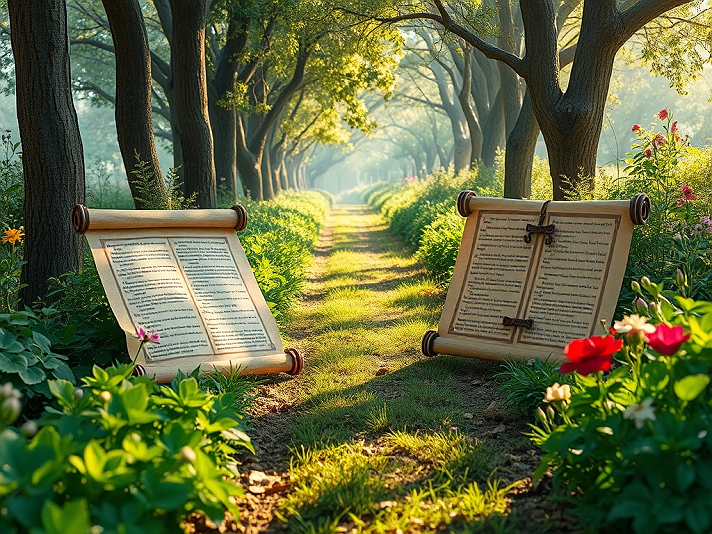"The Verdant Threshold: Scrolls at the Gate of the Unwritten Word"
The path is not a path; it is a sentence. The two scrolls stand at its beginning like open parentheses, their wooden spindles rooted in the earth as though the forest itself had grown them. The avenue of trees stretches ahead, each trunk a serif, each branch a flourish, until the mist dissolves the final period into silence. The scrolls are not abandoned here; they are *planted*. Their parchment is thick, almost fleshy, the color of fresh cream left too long in the sun. The text is printed in a Latin alphabet, but the words are not Latin, not any tongue spoken by human mouths. They are the forest’s own dialect, a scripture written in the language of light and chlorophyll.
The left scroll is tilted slightly forward, as though bowing to the traveler. Its heading is simple: “IN PRINCIPIO.” The text beneath begins with deceptive clarity: “In principio creavit Deus caelum et terram…” before sliding into invention: “et lucem in tenebris vocavit lucem et tenebras vocavit noctem…” The sentences are structured like Genesis, but the nouns have been replaced with verbs, the verbs with colors. “And the earth was formless and void” becomes “And the green was without shape and the shape was without green.” The right scroll answers in the same key, headed “VERBUM CARO FACTUM EST.” Its text is denser, the lines packed tight as moss: “And the word became flesh and dwelt among us, and we beheld its green…” The parchment is so thin that the sunlight behind it bleeds through, turning the ink translucent and the letters into veins.
The path between the scrolls is narrow, no wider than a single footstep. It is paved with fallen leaves, each one a tiny parchment of its own, inscribed with the faint tracery of veins. The trees that line the avenue are ancient, their trunks the color of ash, their bark cracked into runes. The canopy above is a vault of green glass, filtering the sunlight into shards of gold and emerald. The mist at the far end is not weather; it is breath. The forest is exhaling, and the scrolls are inhaling. The text on the parchment is not static; it is *moving*. If you were to stand perfectly still for seven minutes (the exact length of a single breath held in the lungs of the forest), you would see it: the letters rearrange themselves, forming new sentences, then dissolving back into nonsense. The forest is editing its own scripture.
The flowers that frame the scrolls are not decorations; they are punctuation. The pink bloom at the base of the left scroll is a comma, the red one at the right a period. The white daisies scattered along the path are ellipses, trailing off into the mist. The scrolls themselves are not books but *doors*. Their spindles are hinges, their parchment the threshold. To read them is to step between them, to enter the sentence that the forest is still writing. The text is not meant to be understood; it is meant to be *walked*. Each footstep is a word, each breath a clause. The traveler who passes between the scrolls does not leave the path; they become part of it.
The photograph is a moment of perfect equilibrium. The scrolls are open, the path is clear, the mist is waiting. The forest has paused mid-sentence, holding its breath. The text on the parchment is the forest’s heartbeat, translated into Latin by a scribe who could hear it but not speak it. The flowers are the forest’s punctuation, the trees its syntax. The mist is the final clause, the one that will never be written because it is already being lived. The photograph does not invite interpretation; it invites participation. To look at it is to stand at the beginning of the sentence, to feel the weight of the first word on your tongue. The forest is not telling a story; it is *becoming* one, and the scrolls are the threshold where the becoming begins.
In the end, the image is less about scripture than about syntax. The word is not fixed; it is fluid, a river of green light flowing between the trees. The scrolls are not relics; they are seeds. The path is not a destination; it is a verb. The photograph is a single frame in a sentence that will never end, a moment when the forest pauses to inhale the word and exhale the world. The traveler who steps between the scrolls does not read the text; they *are* the text, written in the language of footfall and breath, inscribed on the parchment of the path. The forest is the book, the mist is the margin, and the silence at the end is not absence but the space where the next word will grow.
























